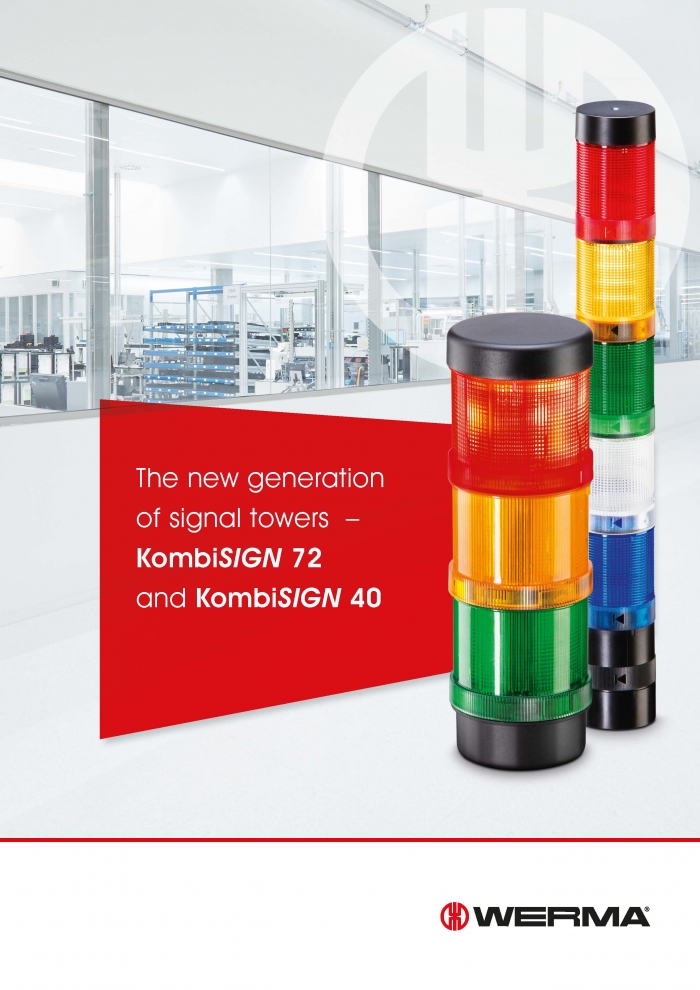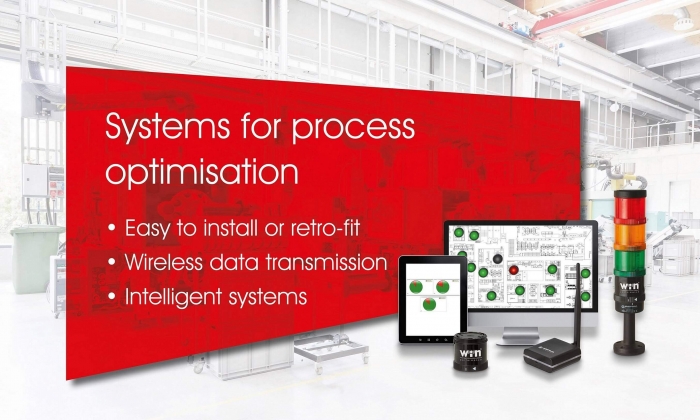Article from WERMA Signaltechnik GmbH + Co. KG
The advantages and benefits of the industrial internet of things all start with communication. In industrial applications a simple event increases the advantages as it goes wireless.
Much has been written about the industrial internet of things (IIoT), or Industry4.0, over the last couple of years. It is a fair bet that many factory managers are still less than clear about what it is and what it signifies. It is certainly not a specification which you can go out and buy, nor is it a norm such as ISO, which a company can be audited against to obtain a certification. Rather, it is simply becoming a new way of industrial life. It consists of a way of doing and organizing things while taking advantages of the benefits of the latest technologies that are available. So, it is evolutionary, not really an industrial revolution, which is often cited together with Industry 4.0.

All photos courtesy of WERMA Signaltechnik
Regardless of how the industry players classify this period that we are all in, one thing is clear: the process all starts with a signal. By taking advantage of the latest technology to digitalize how you can manage aspects of today’s business, clever solutions are embracing the spirit of the IIoT thinking. Increased use of automation combined with the latest process improvement tools speed up processes. It can make them more transparent and reduce the amount of human errors and inaccuracies often caused by traditional methods of recording certain types of information - even if it is old school: via clipboard, pen and spreadsheet.
During the specifying process of acquiring a large capital expenditure such as a machine, a great deal of thought needs to go into what value it will bring to the company and how it will be employed. It is smart for companies to include the operations and maintenance personnel as decision makers to add their perspective to the traditional decision makers in both the administration and finance departments. This inclusion provides a well-rounded justification in the determination of the payback period and ultimately the feasibility of acquiring such a large capital expenditure. Their inclusion can prolong the life of the asset if it is well thought out.
A machine feature as simple as a stack light can also extend the machine’s life. To meet that objective, enhancing a stack light design to include communication in addition to signal notification is now possible. For example, a manufacturing engineer specifying a machine applies a philosophy of what parameters are important enough to warrant an alarm that notifies when parts are being produced out of specification. However, expecting someone to be present when the alarm is triggered is not realistic because in today’s manufacturing environment both multitasking and “doing more with less” have become a way of manufacturing life. Another way to put it is there should be stack light indication of a machine’s parameters that would be used to tell its lifetime story. Think of what you would want to know regarding a machine’s health if you were looking to buy a used piece of equipment?

With the signalling of the critical machine parameters in place, next focus on getting the information to the proper personnel is a must. How is the information to start then flow? Consideration of capitalizing on the benefits of a low-cost, smart, easy-to-install/retrofit process optimization system in your process all starts with communication. You just need to simply get the signal.
The complexity of technology has advanced to an involved level of sophistication that all starts with an “event.” Fundamentally these events are nothing more than the simple closure or opening of a 24-volt circuit based on an input. Stack lights or “Andon” lights are the product of choice to start the process. Whether the input is a manual operation of a push button or an automated action from a sensor, this seemingly minor electrical circuit change can trigger a chain of problem-solving events when carried out by clever equipment designs.
You have to wonder if Professor Nick Holonyak, the American scientist at General Electric who accidently invented LEDs in the early 1960s, could envision back then that simply turning on his “mistake” would trigger so much value in a production environment. As a result two system-type solutions have emerged to solve specific process issues. Firstly, some automated solutions use conventional Andon lights. With the addition of a wireless transmitter and receiver kit to monitor up and down time of machines and other equipment, stack light communication of equipment status can become instantaneous. The age-old problem with stack lights has been whether someone is nearby to see or hear the alarm once it is energized. The signal device is worthless until someone receives the message that a problem now exists. Receiving this information is paramount in being able to respond. This is why today’s leading-edge solutions use wireless technology to notify the proper and needed responders. Sending texts and emails allows for specific targeting of the proper people while messages displayed on large screens throughout a facility lend themselves to a broadcast-type of notification. Simply put, transforming a stack light into a smart stack light enable remote monitoring. With this equipment status, the situation allows for a WIN-WIN solution. That is the needed response can now be a WIN – WIN solution: Where It’s Needed - When It’s Needed.

When used in conjunction with a machine, typical internal sensors do the monitoring with their 24-volt digital outputs at the ready. Data collection systems can also collect and display other relevant data on machine performance including: real-time status, changes of that status, historical data, production performance, summary reports and strength of communication signals. When more advanced software is employed, advantages from higher levels of sophistication result. These advantages include but are not limited to: counting parts, scheduling production, maintenance planning and signaling a head-of-line status.
In addition to data collection, often times the more important benefit from these technologies is the content and meaning of the information and the speed of receiving this information. Keeping a history of key machine parameters is necessary but being made aware of a machine status change as it happens is often critical. This basic need then employs other technologies when considering the means of transmiting the information. For fast reliable communication, wireless is the obvious answer. With its infrastructure in place (e.g. satellites, cell towers, hand-held devices being readily available) wireless technology is here to stay. That is the reason it is designed in as the means for transmitting the signal and sharing the communication of these “events.” From there clever designs in software can provide additional features such as choice of SMS texts or voicemails or pop-up notifications for production area video screens or delayed notifications to support a personnel hierarchy.
Secondly, other system solutions include stack lights but are based on a wireless call-for-action system. This solution is proving popular in many on-line retail warehousing operations as well as industrial operations because of the manual actuation of initiating the communication signal. Not relying on a machine-based sensor, human interaction is required for starting these processes. The system will identify bottlenecks in a warehouse system and speed up response to disruptions in the production process. Again, notification in the immediate area is done via a local stack lights being energized. The same benefits of the machine-based, automatically sent, wireless transmitter signals can be capitalized on. While this system depends on the discipline of starting the process with manual intervention, stressed employees concurrently running multiple pieces of equipment welcome the opportunity to call for help when it’s needed.
In summary, simply starting with an electrical circuit change typically associated with an Andon light, a stack light can trigger a sequence of events to both notify personnel of equipment status in real time while storing its data and cleverly bringing value-added to improve productivity. With clever design engineers such a simple concept can provide a stack light that can:
- provide an overall view of all equipment being monitored
- provide transparency of status and responsibilities
- shorten machine and process downtime
- ensure and improve productivity
- display a dashboard of real-time performance information
- allow production scheduling
- notify a hierarchy of remote personnel of status changes
- count parts being produced
- alert personnel of nearing the end of a production run
- generate production-based reports
- maintain a living history of the machine for specified parameters
- schedule preventive maintenance
- provide historical performance data
- become a “head of line” function
- provide notification signal diagnostics
Not too bad for a mistake in the lab that was applied to a product line that almost slipped into becoming a commodity.
WERMA’s solutions come in the form of two new smart and intelligent process systems, both designed to play their part in eliminating HMI-related weaknesses in process chains and replacing them with fail-safe automated systems.

SmartMONITOR: the smart alternative for machine monitoring and data collection.
As an optional element to WERMA’s modular stack light offering, the SmartMONITOR helps to make processers lean, faster and more efficient. The wireless-based data collection and transmission system is easy to retrofit and enables analyses of an operation which in turn will lead to untapped growth potential and keeping you one step ahead of the competition. SmartMONITOR is the intelligent machine monitoring system alternative for companies who are looking for a quick and uncomplicated way of optimizing their processes. This solution will provide you with all relevant data on the performance of machines, equipment and manual workstations, simply with a couple of mouse clicks.
AndonSPEED: transforming traditional stack lights wirelessly into networked call-for-action systems.
AndonSPEED is simple to use, easy to understand, very easy to install and can be expanded based on its modular design. Status changes are transmitted wirelessly from the workstation to a central control station and, if needed, can be sent by automatic e-mail to the appropriate response team. An optional feature of “head of line” capability provides a centralized overview of all workstations statuses.
Advantages include speeding up your team, logistics and ultimately your process by exposing weak spots, precisely documenting non-productive times thereby reducing down time at the workstations and improving efficiency.
Related Glossary Terms
- modular design ( modular construction)
modular design ( modular construction)
Manufacturing of a product in subassemblies that permits fast and simple replacement of defective assemblies and tailoring of the product for different purposes. See interchangeable parts.
- turning
turning
Workpiece is held in a chuck, mounted on a face plate or secured between centers and rotated while a cutting tool, normally a single-point tool, is fed into it along its periphery or across its end or face. Takes the form of straight turning (cutting along the periphery of the workpiece); taper turning (creating a taper); step turning (turning different-size diameters on the same work); chamfering (beveling an edge or shoulder); facing (cutting on an end); turning threads (usually external but can be internal); roughing (high-volume metal removal); and finishing (final light cuts). Performed on lathes, turning centers, chucking machines, automatic screw machines and similar machines.






